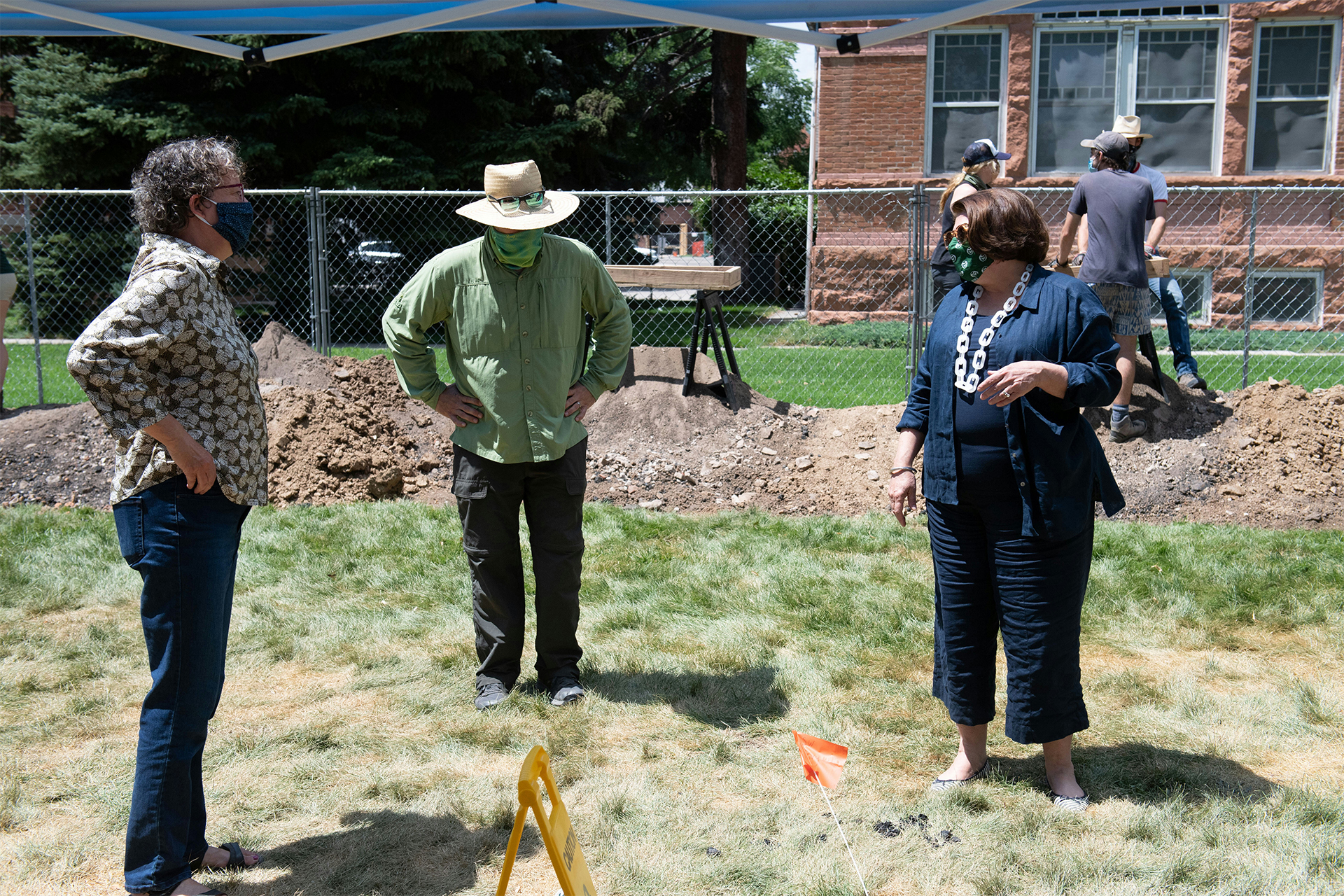Claim Building archaeology dig continues with visit from President McConnell
Video by Ron Bend/CSU Video
After three weeks of helping dig three rather large holes just a few steps from one of the busiest intersections in Fort Collins, Bobbie Abeyta is used to seeing curious onlookers outside the fences on the grass of the northeast corner of Colorado State University’s campus.
Abeyta is one of 13 people participating in the annual Archaeology Field School – a required course for students majoring in archaeology in the Department of Anthropology and Geography. They are excavating the site of the Claim Building – the first structure built on CSU’s campus 150 years ago.
The group is led by Assistant Professor Ed Henry and Professor Mary Van Buren and includes 10 students and a teaching assistant. The three meticulously dug holes and the resultant plies of dirt are easily visible to vehicles and pedestrians as they travel near the intersection of College Avenue and Laurel Street.
“We have people stop by every day, checking out the holes and asking about the project,” Abeyta said. “When you think of archaeology you usually think of digging in the middle of a jungle somewhere. This dig is in a very public place, and it’s been cool to see so many people interested in what we’re doing.”
But while onlookers peering through the fencing have become a regular occurrence, Abeyta was more than a little surprised Friday when a new visitor – CSU President Joyce McConnell – stopped by.
“I was kind of nervous to meet her,” he said. “You just don’t expect the president of the university to show up at one of your classes, but she was great. She was very interested in the project and was really cool to talk to.”
President McConnell’s visit

McConnell had a couple of reasons for wanting to visit the dig. First, it was a chance to learn about the unique project exploring CSU’s roots. Second, it gave her an opportunity to see how this class was functioning under COVID-19 guidelines that will be adopted for other classes when the fall semester begins in just over three weeks.
“This is a really important class because it serves as an example of how to successfully hold similar classes,” she said. “Applied learning is one of the most exciting ways to learn. It engages the students like nothing else. I love it.
“But the lessons we’ve learned here will really help us set protocols for classes in the fall. These students are the leaders – the ones who will tell others about how important it is to wear masks and social distance. Students might not listen to me or any other adult, but they’ll listen to their peers.”
Participants and visitors at the site had to have their temperature taken and answer questions about COVID-19 symptoms before entering the fenced area. Masks were required at all times, and social distancing was enforced – even for those digging in the largest of the holes, which is 9-feet deep.
“We’re kind of a flagship class for CSU,” said Abeyta, a junior seeking a minor in business to accompany his major in archaeology. “We wear the masks every day, even when it’s 80, 90 degrees. If we can do that, people can wear masks in class and on campus.”
While McConnell was pleased with how the field school participants handled protocols, she was also intrigued by the aim of the project: learning about the earliest days in CSU’s history. The Claim Building – rather small at 16 x 24 feet – had many roles during its short history, including serving as a temporary residence for the school’s first president, Alston Ellis, his wife and three children.
“Let’s just say I’m happy to be CSU’s 15th president and not the first, who had to share that tiny space with four other people and no indoor plumbing!” she said with a laugh.
Thus far, the dig has produced a number of interesting finds: an 1868 dime, a bullet, several pieces of broken glass, nails, jewelry, a pile of bricks and remnants of an apparent chemistry lab. There is hope that the dig will uncover evidence of the indigenous people – members of the Ute, Cheyenne and Arapahoe tribes – who occupied the land before it was designated as the site of the state’s land-grant university.
The class will spend another week on the project before replacing the dirt. Henry said he hopes his students can revisit the site in future years and continue to unravel the secrets of CSU’s past.
“We keep developing hypotheses as we dig further and learn more from what we’ve discovered,” he said. “It’s like doing a 1,000-piece puzzle and then finding a piece that doesn’t seem to belong. We’ve still got a lot to learn, and that’s exciting.”
Learn more
Discover more about CSU archaeology students’ efforts to literally unearth the long-buried history of the first building on campus at col.st/lNAOx.